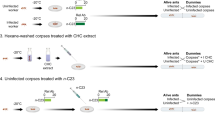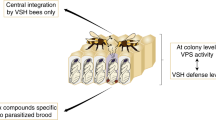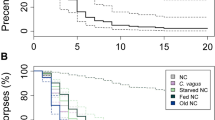Subterfuge used by a rare wasp may be the key to an alternative type of pest control.
Abstract
Insect social parasites are extreme specialists that typically use mimicry or stealth to enter ant colonies to exploit the rich, but fiercely protected, resources within their nests1,2,3. Here we show how a parasitic wasp (parasitoid)4 contrives to reach its host, itself an endangered species of social parasite that lives inside the brood chambers of ant nests, by releasing semiochemicals to induce in-fighting between worker ants, locking the colony in combat and leaving it underprotected. Four of these chemicals are new to biology and have the potential to control pest species by inducing different agonistic behaviours in ants.
This is a preview of subscription content, access via your institution
Access options
Subscribe to this journal
Receive 51 print issues and online access
$199.00 per year
only $3.90 per issue
Buy this article
- Purchase on Springer Link
- Instant access to full article PDF
Prices may be subject to local taxes which are calculated during checkout

Similar content being viewed by others
References
Elmes, G. W., Barr, B., Thomas, J. A. & Clarke, R. T. Proc. R. Soc. Lond. B 266, 447–453 (1999).
Hölldobler, B. & Wilson, E. O. The Ants (Springer, Berlin, 1990).
Dettner, K. & Liepert, C. Annu. Rev. Entomol. 39, 129–154 (1994).
Godfray, H. C. J. Parasitoids (Princeton Univ. Press, 1994).
Thomas, J. A. & Elmes, G. W. Anim. Behav. 45, 593–602 (1993).
Akino, T., Knapp, J. J., Thomas, J. A. & Elmes, G. W. Proc. R. Soc. Lond. B 266, 1419–1426 (1999).
Sledge, M. F. et al. J. Insect Physiol. 46, 753–761 (2000).
Wilson, E. O. & Bosert, W. H. Recent Progr. Hormone Res. 19, 673–716 (1963).
Billen, J. & Morgan, E. D. in Pheromone Communication in Social Insects (eds Vander Meer, R. K., Breed, M. D., Winston, M. L. & Espelie, K. E.) 3–33 (Westview, Colorado, 1998).
Klotz, J. H., Greenberg, L., Shorey, H. H. & Williams, D. F. J. Agri. Entomol. 14, 249–257 (1997).
Lawton, J. H. Ecol. Entomol. 26, 225–226 (2001).
Author information
Authors and Affiliations
Corresponding author
Ethics declarations
Competing interests
The authors declare no competing financial interests.
Supplementary information
Rights and permissions
About this article
Cite this article
Thomas, J., Knapp, J., Akino, T. et al. Parasitoid secretions provoke ant warfare. Nature 417, 505–506 (2002). https://doi.org/10.1038/417505a
Issue Date:
DOI: https://doi.org/10.1038/417505a
This article is cited by
-
Chemical tactic of facultative myrmecophilous lycaenid pupa to suppress ant aggression
Chemoecology (2018)
-
Between-group competition elicits within-group cooperation in children
Scientific Reports (2017)
-
Rediscovery and reclassification of the dipteran taxon Nothomicrodon Wheeler, an exclusive endoparasitoid of gyne ant larvae
Scientific Reports (2017)
-
Arthropods Associate with their Red Wood ant Host without Matching Nestmate Recognition Cues
Journal of Chemical Ecology (2017)
-
Myrmica ants host highly diverse parasitic communities: from social parasites to microbes
Insectes Sociaux (2014)
Comments
By submitting a comment you agree to abide by our Terms and Community Guidelines. If you find something abusive or that does not comply with our terms or guidelines please flag it as inappropriate.



